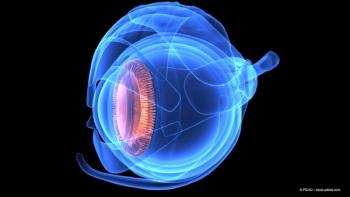
Casting a new light on fundus imaging
Short FLIO flecks may appear before changes are seen on other imaging modalities, including OCT.
This article was reviewed by Shawn Kavoussi, MD.
Fluorescence lifetime imaging ophthalmoscopy (FLIO) is a rapid noninvasive autofluorescence imaging modality that provides additional disease details beyond conventional imaging modalities. Using FLIO lifetimes—that is, the rates of autofluorescence decay—different autofluorescence patterns can be appreciated in affected eyes with various retinal diseases.
This novel technology casts a new light on fundus imaging by providing different colorful perspectives of retinal diseases that were not available previously, and all in about 2 minutes.
“This novel technology detects the in vivo autofluorescence lifetimes at the back of the eye,” according to Lydia Sauer, MD, from the Department of Ophthalmology and Visual Sciences at the Moran Eye Center, University of Utah School of Medicine, Salt Lake City, Utah.
Healthy eyes, she explained, exhibit the same characteristic pattern of short FLIO lifetimes in the foveal center and long lifetimes at the optic nerve. In contrast, eyes with retinal diseases are characterized by numerous different autofluorescence patterns depending on the diseases present.
Sauer and colleagues studied the phenotypes, genotypes, and longitudinal changes in Stargardt disease in 45 genetically characterized patients (mean age, 39 years), of whom 35 had the ABCA4-associated STGD1, 3 had ELOVL4-associated STGD3, and 7 had PRPH2/RDS-associated macular dystrophy, the last 2 of which are similar to Stargardt disease. Ten patients were followed longitudinally for a mean of 19 months.
Phenotypes
Three phenotypes have been identified previously in patients with Stargardt disease ABCA4-associated STGD1. Type 1 is characterized by only a central lesion, type 2 flecks across the macula, and type 3 large atrophic areas. Imaging technology took a step forward with the advent of FLIO, which also shows these lesions. However, FLIO also demonstrates both significantly different lifetimes among the 3 phenotypes and that the lifetimes in the foveal center are correlated significantly with the best-corrected visual acuity, Sauer noted.
Sauer and colleagues reported a particularly important finding,1 that is, FLIO demonstrated that the geographic atrophy secondary to AMD has a markedly different appearance from the retinal atrophy associated with Stargardt disease; in contrast, the 2 diseases can appear very similar when using autofluorescence intensity imaging. The investigators also reported previously that eyes with AMD were characterized by a ring with prolonged lifetimes that are seen as a shift to blue at the fundus; in contrast, that pattern is not seen in eyes with Stargardt disease. This pattern difference facilitates easy differentiation of the 2 diseases.
Genotypes
Sauer also is studying the different genotypes in patients with ABCA4-related Stargardt disease.
“We believe that FLIO imaging can show differences among the many different genetic subtypes,” she said.
Longitudinal analysis
Another area of research interest is the evaluation of the details in eyes with ELOVL4-associated STGD3 and PRPH2/RDS-associated macular dystrophy, which are Stargardt-like dystrophies.
“It is very interesting that all eyes with PRPH2/RDS-associated macular dystrophy showed flecks of short FLIO lifetimes,” she noted.
This is noteworthy because the baseline FLIO image showed some flecks of short FLIO lifetimes that were not visible on the baseline autofluorescence intensity image but only appeared 1 year later on a follow-up image.
“At that time, the FLIO lifetimes are prolonged from short to long and the patient we examined reported a new central scotoma where an area of markedly prolonged FLIO lifetimes was seen on the follow-up image,” she said.
Sauer explained that the relevance of this research is that the short FLIO flecks appear before changes seen on other imaging modalities including OCT.
The researchers believe that when the short FLIO lifetimes are seen, they may be reversible because they precede structural retinal changes. However, by the time the changes appear on other imaging modalities, reversing them may be impossible.
These flecks also appear in some patients with Stargardt disease and Sauer noted that they behave the same as in PRPH2/RDS-associated macular dystrophy. FLIO lifetimes show a characteristic pattern in Stargardt disease, and different phenotypes can be identified. Different genotypes have characteristic FLIO findings.
“The most important finding is that short flecks initially identified by FLIO imaging prolong over time and these changes seen on FLIO imaging are visible before appearing on OCT images and other imaging modalities,” Sauer concluded.
Reference
1. Sauer L, Gensure RH, Andersen KM, et al. Patterns of fundus autofluorescence lifetimes in eyes of individuals with nonexudative age-related macular degeneration. Invest Ophthalmol Vis Sci. 2018;59(4):AMD65-AMD77. doi:10.1167/iovs.17-23764
Lydia Sauer, MD
E: Lydia.Sauer@hsc.utah.edu
Sauer is a medical consultant to Tesseract Health and receives nonfinancial support from Heidelberg Engineering.
Newsletter
Keep your retina practice on the forefront—subscribe for expert analysis and emerging trends in retinal disease management.















































